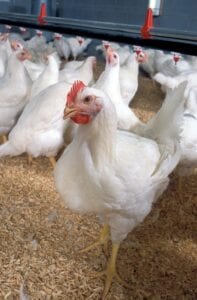Chicken
Chicken Breeds
The most common breeds available today are single-purpose birds; they are reared for either meat or eggs, not both.
Broilers (Meat Birds)

The most common commercial meat bird in the world is the Cornish Cross, which have been specifically bred to put on weight faster than any bird on Earth.
In confinement (factory conditions—not what we do on a homestead) a Cornish Cross can reach harvest weight in a mere six to eight weeks. This massive growth rate combined with no exercise causes all sorts of health problems that don’t end with the chicken, they can also affect those who consume them.
While these lumbering brutes have lost their ability to forage as effectively as heritage breeds, they are usually the easiest to source and do get great benefit from free-ranging. They grow a little slower out of confinement thanks to the exercise they benefit from, but the health, flavor, and texture of the meat is greatly improved.
A well-fed broiler on good pasture will grow to about four-and-a-half pounds in 10 weeks. Heritage breeds will take longer but have a richer flavor and can forage for more of their own feed.
Automatic chicken pluckers are available online if you are going to be processing more than a couple birds per week. Check online for suppliers like www.backyardchickens.com.
Layers (Egg Birds)
Hens start laying sometime after 22 weeks of age and will continue until you cull them, which should be done after a few years.
You don’t need a rooster to get eggs from your hens, but the eggs they lay without a rooster are sterile and wont hatch into chicks. To be truly self-sufficient, you should consider keeping a rooster in order to naturally replace your hens as they grow older. Of course, this will mean that any eggs you allow to be fertilized and hatched will be about 50% male… depending on the species you’re raising, the roosters could be used for meat. In any case, you’ll have to either eat, sell, or otherwise deal with the males as they come so you don’t end up with a coop full of roosters.
A small flock of six hens—which can be fully fed from table scraps and free-ranging—will produce more than four eggs per day… that’s about 130 dozen organic, free-range eggs per year. You can’t beat that production-to-effort ratio! In addition to being easy and cheap to feed from your wastes and upcycling it into fertilizer for you, they’ll also keep your yard pest-free through foraging.
A small-scale commercial egg production of 30 laying hens will produce over 1,000 dozen eggs per year—over 20 dozen eggs per week. While a flock of this size will mean more upkeep for you, they easily turn an immediate profit. Plus, it’s a reliable income you can count on every week once you find a sales outlet.
Dual-Purpose Birds

The Rhode Island Red could be considered a dual-purpose bird, as the roosters grow big enough to make it viable to raise them for meat and the hens are good layers.
They will not achieve the size of the formidable Cornish Cross, but if you breed your own birds, roosters will be available for free right on your farm and you could consider raising the roosters to maturity to eat.
There are many decent egg-laying birds available these days, but my favorite is the reliable Rhode Island Red, a good layer of brown eggs. If cared for properly, these birds can produce 250 each per year (5 eggs per week each).
Rearing Chicks
The enclosure in which you rear chicks is called a brooder, and it should offer the chicks plenty of dry bedding, along with easily accessed food and water. (Place pebbles in the waterer and to prevent very young chicks from falling in and drowning.)
Unless you breed your own chicks, you’ll need to keep bought chicks warm under a heat lamp until their feathers grow. Hang a red heat lamp over the chick’s brooder (ensure there is no danger of the bedding catching fire). If the chicks stay huddled under the lamp, they are too cold and the lamp should be lowered or another added. If the chicks are spread out and none are under the lamp, then it’s too hot and the lamp should be raised. When the chicks’ feathers grow (after at least 4 weeks) they can be put out on pasture if the weather is favorable.
Broody Hens
Modern hens have begun to lose the mothering instinct their wild cousins are born with… Hens that display the mothering instinct are said to be “broody,” and they’ll sit on any eggs in a nest box all day and night attempting to hatch them. Others have no interest in brooding.
Certain breeds are known for a strong mothering instinct. When they get broody you can put any fertile eggs under them and they’ll sit on them until they hatch.
If you have fertile eggs, put them under broody hens, with feed and water be close by—she’ll typically only leave the eggs once to eat and drink before she returns to sit on her clutch (nest of eggs). She turns the eggs slowly with her beak about 50 times a day to prevent the yolk sticking to the inside of the egg and killing the chick.
Many breeds of commercial birds won’t sit on their own eggs to hatch them, meaning if you want to hatch your own chicks you’ll have to purchase an incubator and turn the eggs several times per day by hand.
Other Poultry
All domesticated poultry have just about the same requirements. The only change you need to make to farm other types of birds is to size their housing accordingly.
